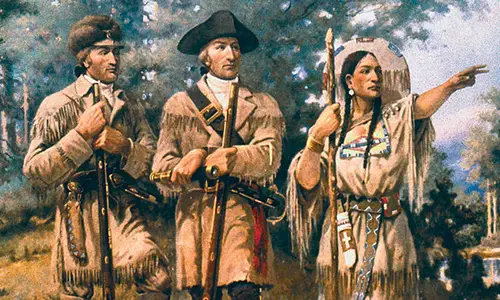In 1803 after President Thomas Jefferson purchased the Louisiana territory from France he initiated an exploration of the newly purchased land and the region beyond the “great rock mountains” in the West. President Jefferson chose his personal secretary, Meriwether Lewis, who in turn solicited the help of William Clark to aid him in the exploration.
Fact 1: Jefferson was hoping that Lewis and Clark would find a water route linking the Columbia and Missouri rivers. This would connect the Pacific Ocean with the Mississippi River system, thus allowing the new western land access to port markets out of the Gulf of Mexico and to eastern cities along the Ohio River and its minor tributaries.
Fact 2: The Lewis and Clark Expedition paddled its way down the Ohio as it prepared the Expedition to be launched officially from Camp Wood, just outside St. Louis, in the summer of 1804. The company of explorers paddled upstream, northwest on the Missouri River to Fort Mandan, a trading post, where Corps of Discovery and they decided to set up camp for the winter and then prepare for their journey to the Pacific.
Fact 3: In the spring of 1805, the Lewis and Clark Expedition set out on their next journey, they traveled up the Missouri to present-day Three Forks, Montana, wisely choosing to follow the western-most tributary, the Jefferson River. This route introduced them to the Shoshone Indians, who were skilled at traversing the great rock mountains with horses. Once over the Bitterroot Mountains, they shaped canoe-like vessels that transported them down the river to the Columbia, where they set up camp for winter at Fort Clatsop, on the present-day Oregon side of the river.
Fact 4: Lewis and Clark returned to St. Louis by September 1806 to report their findings to Jefferson. The traded what few goods they had left with the Indians and set up diplomatic relations with the Indians.
Fact 5: Along the Expedition William Clark drew a sequence of maps that were very detailed, noting and naming rivers and creeks, significant points in the landscape, the shape of river shore, and the places where they spent each night or camped for a long period of time.
Fact 6: The Expedition took 863 days; they traveled a total of 7,689 miles through unmapped and unsettled wilderness.
Fact 7: Lewis created a collapsible canoe with an iron frame for the journey. It could be covered with animal skins and could carry up to one ton of weight. It only weighed 44 pounds and he named it experiment.
Fact 8: Lewis purchased a teepee from Sioux in April 1804. Sacagawea took it down and put it back up daily. Lewis, Clark, Sacagawea, Pomp, Drouillard and Charbonneau slept in it every night.
Fact 9: On August 12, 1806 Lewis was shot in the buttocks by a one eyed expedition member named Cruzatte, who mistook him for an elk.
Fact 10: Lewis became a soldier at an early and fought in the Whiskey Rebellion in 1794, soon after he became an officer in the Army and battled the Native Americans in the Northwest Territory of the new nation. Lewis was well educated about the Native Americans and learned how to speak some of their languages.
Fact 11: The Lewis and Clark expedition discovered more than 300 plants and animals, including the American bison, mountain lion, coyote, wolverine, whooping crane, Lewis woodpecker, and the golden eagle.
Fact 12: Lewis was considered an exceptional leader, and was highly respected by the members of the Corps of Discovery. He recorded a lot of the events of the expedition in his journal and it is one of the most important documents in American history.











Leave a Reply